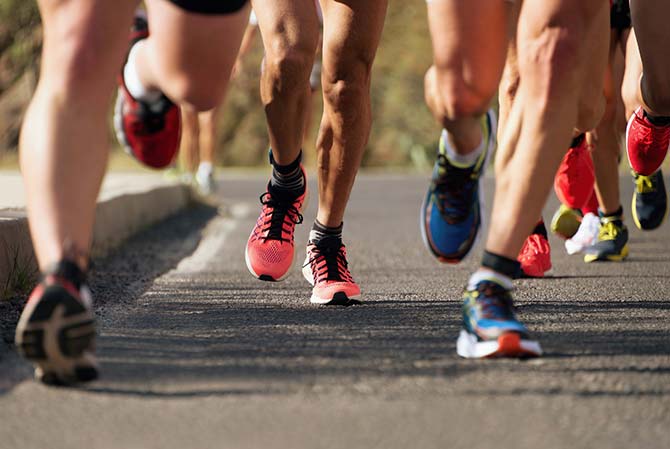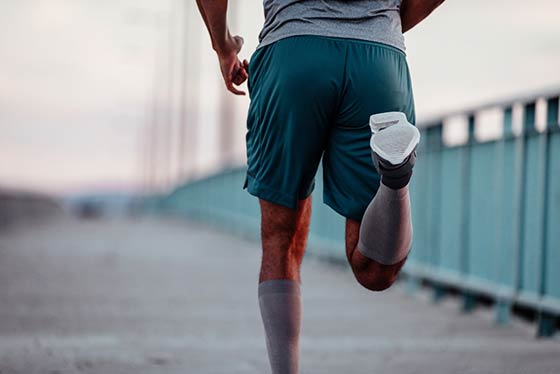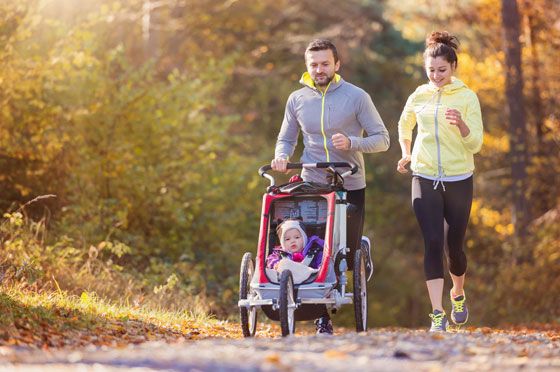Marathon Training and Preperation
Professional training tips from Anna & Lisa Hahner

The marathon is the supreme discipline of track and field - a whole 42 kilometres! Sounds impossible? Not for Anna and Lisa Hahner: In an interview, the two marathon and running experts teach us proper marathon preparation and give you practical tips for your next run.
Marathon training: The most important tips at a glance
1. Goal Management
2. Preparation
... Distance or Time
... Finding the right Training Programme
... Strength Training and Daily Life
... Breathing Correctly
... Posture
... Nutrition
3. The Marathon Run
... Clothing and Shoes
... Mental Power
... Nutrition During the Run

The marathon experts: Interview with Lisa & Anna Hahner
Lisa and Anna Hahner (born 1989) are the best known runners in Germany. Since 2008 the sisters, known as "Hahnertwins", have regularly participated in marathon races. Their greatest successes came at the Rio Marathon 2015 (2nd place) and at the German Championship 2015 (1st place). Lisa and Anna Hahner are also authors of the book "Time to Run" (spomedis-Verlag, 2016).
1. Goal Management
You want to run a marathon? This is the first step. But before you do so, the question arises whether a half marathon is not more suitable, so you don't take off more than you can chew: Anna and Lisa claim that in theory anyone can run a marathon. But keep your goals realistic.
The sisters point out that it makes sense to do one or better several half marathons or 10 km runs. The runs with shorter distances serve as "an approach to the long distance." Furthermore, runs with shorter distances put less strain on the muscles and joints. Running smaller runs before bigger ones is a sensible way to improve your own endurance bit by bit.
Anna and Lisa Hahner know from their own experience how meaningful interim goals are: "On the one hand you remain motivated and on the other you can see whether you are on the right track."

How much time you spend training decides how lofty your goals may be. The best thing to ask yourself before your marathon training is: How many times a week do I want and can I train realistically?
Don't be too ambitious. "The more time you can spend on training, the more ambitious you can set your goal."
2. Preparation
Training correctly is essential for effective marathon preperation. You should never run a marathon untrained.
Anna and Lisa Hahner know that for performance athletes a typical marathon preparation takes three months. However, they run several times a day all year round. A hobby athlete cannot keep up with such an intensive preparation. As a leisure athlete you should therefore plan "six to twelve months of training for your first marathon."
Keep in mind that you may have to train in the winter. But don’t let low temperatures scare you. You can find the Do’s and Dont’s of winter running in the article Jogging in Winter.
But no matter whether summer or winter: Always orientate your marathon training towards your own level of fitness and performance. This means don't compare yourself to other runners and their times, but focus on your training alone. That way, you can build up sustainable performance and see improvements.

The right metric for marathon training: distance or time?
This question puzzles many runners. There are different opinions on the question whether distance or time is more important when measuring performance. For Anna and Lisa Hahner, the combination of distance and time makes sense: "Both distance and time play an important role in training."
In the preparation phase, you should run several legs of 30 kilometers where speed does not matter. At the same time, you should run as often as possible at competition speed.
Nevertheless, the following applies: Try out what works best for you.
The right training plan for your marathon preparation
It is recommended to train for a marathon via a training plan. However, you should always "adapt your running plan to your individual situation and take into account your current level of performance. Because rarely does training run according to plan".
How do I find the right training plan?
A performance analysis or placement test , (often offered by doctors, hospitals and specialist companies) can help you create your own custom training plan: The treadmill measures your body's maximum oxygen intake anaerobic levels. These values can be used to determine what your training plan looks like.
Static training programmes lay out a fixed schedule until the day of the event. Neither individual strengths and weaknesses nor the personal situation of the runner are taken into account. This leaves less leeway in case of accidents or unforeseen circumstances and may not cater to the athlete’s individual development. This can lead to frustration or athletic stagnation.
A dynamic training programme can get around this with the help of running apps. The user can send feedback about the training circuits, so the training plan can get the most of its user. In cases of unforeseen circumstances, like sickness or injury, a dynamic trainings plan allows the user to more easily start and stop.
If you have to pause your training several weeks before the marathon, you should focus on racking up Miles and Kilometers once you begin running again. If your training pause happens closer to the marathon, your health is the most important: Shoot for a slower time or decide against the marathon.
Tip: The Hahnertwins Running Club
Besides the app, the marathon sisters run the Hahner twins’ Running Club (HR-Club) (in German). Those who join receive motivational messages and mental tips from both experts, individual run analyses, a big community with 4-6 group runs a year and much more.

Building muscle, strength training & stretching
Finding the right Training Programme
Extremely important: stretching. Because with the correct exercises before and after running training you minimise the risk of injury to your muscles. Therefore, never do without a proper warm-up and cool-down!
Simulate a competition
Anna and Lisa Hahner advise you do the following to prepare you for competition: "Do as you would on the day of the big run: Get up at the same time, same breakfast, put on the same clothes, same food". That way, your body knows what to expect on the day of the marathon.
Training and Daily Life
Combining Training and everyday life is no easy task! Work, kids, family and marathon training, all in one? No problem.
“Treat running like an appointment you’d put on a calendar. You’ll find yourself treating it as such. Try biking to work and then running back home in the evening. The next day, run to work and bike back. That way you can do the environment a service and feel good while doing it!”
For the last two weeks, keep in mind: Reduce the frequency and intensity of your runs before the event. Instead of running, taper. Tapering is a reduction of training intensity.
Alongside tapering, a healthy balanced breakfast and plenty of sleep is very important.

Breathing Correctly
„Breathing is an important component of maximising your energy output and ensures you reach your peak performance potential.” Normally, your body automatically regulates your breathing. If not, the Hahner twins recommend Pilates and yoga. “So that you become more attuned with your breathing – that also applies to men!”
When running, pay attention that you breath with your mouth, so that you can take in more oxygen. For efficient breathing, it’s also essential that you run with a correct and relaxed posture.
Posture
Have you ever watched someone jog? While each has their own running style, you should brush up on the basics. Running with poor posture wastes energy and can even lead to injury.
You can find out how to develop the right running form in our guide "The right running technique".
Nutrition
It is a known fact that nutrition plays a crucial role in training. But is it true?
While Training for the Marathon
“A healthy and sensible diet promotes athletic performance. We pay careful attention that the food we consume is rich in protein and fresh.”
"We like to have porridge before training. The oatmeal is satisfying, has a good ratio of carbohydrates to protein. With cinnamon and a few berries it tastes very delicious."
Directly after training you can have a shake made of milk and fruits.
Before the Marathon
For the day of the race, you need to find the marathon breakfast the works for you. Listen to your stomach Before a race, Anna and Lisa Hahner usually eat bread rolls with honey or jam, scrambled eggs and go without fruit - except for bananas, which are rich in carbohydrates. But they've also meet runners from Japan eating noodle soup or British runners cooking bacon and eggs.
You will find much more useful information about nutrition and sports in our article about sport nutrition and diet for your training.

3. The Run
The big day has arrived and you stand before the starting line. With the help of the following tips, you should be well-prepared for any potential issues.
Clothing and Shoes
Regarding proper clothing and shoes for the marathon run, consider the following points:
- Be sure to check the weather in advance and wear similar clothing to those you wore when training. Since marathons usually start early, dress warmer to deal with morning fog or mist. Once you get started, you’ll warm up.
- In the morning, wear an old sweater, which you can place on the side of the road before the start without hesitation.
- Don't wear new shoes during the competition. Your running shoes should be properly worn in, but not worn out. The same goes for your running clothes during marathon training.
- For men, we recommend covering nipples with a plaster to prevent chafing.
Running as a team? Then show that you belong together by creating a team jersey or bandana in our 3D Designer.
The Right Frame of Mind
Lisa and Anna recommend positive thinking. It especially helps for running, get excited over improvements! “Every step that you take is a step closer to your goal.” You can use the euphoria and enthusiasm of the crowd in order to motivate yourself and win positive energy.
Use the excitement and enthusiasm of the crowd to motivate you. It is of course ideal if family and friends support and cheer you on.
By the way: More detailed tips on mental strength and motivation can be found in our guidebook "Mental Training in Sports" by mental trainer Andreas Mamerow.
Nutrition During the Run
Besides the mental component, nutrition during the run plays an important role in your stamina. Make sure to drink enough water during the run. How much and when depends on the air temperature, your own weight and running speed.
Besides drinking enough water, getting enough calories through carbohydrates is very important. Energy bars are perfect as they are packed with carbohydrates, which your body can easily convert to energy. If you don’t get enough energy, you can go hungry and under perform.
Important: Regarding provisions and equipment, make sure you try nothing new come race time. Wear what you know and eat/drink what you know. On the day of the race, your body should be used to the food and clothing, so that you don’t run into any problems.

Great Job!
Get started: We wish you good luck, but above all we wish you lots of fun during your marathon training!
Images: Cover image: © Hahnertwins; Images: © iStock/sanjeri; © iStock/jelenahinic; © iStock/Halfpoint; © Hahnertwins; © iStock/Halfpoint; © iStock/FatCamera